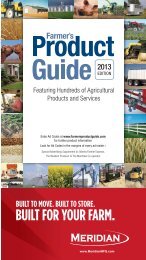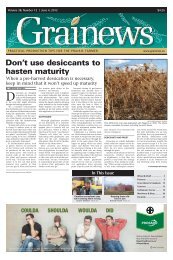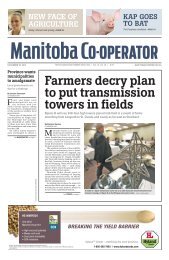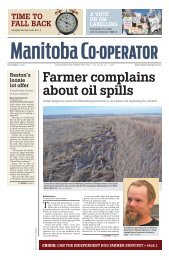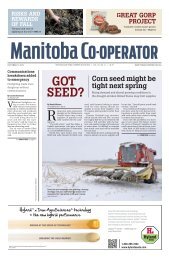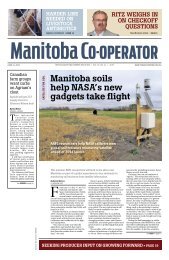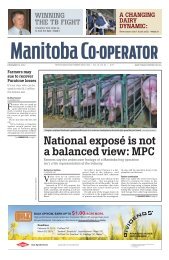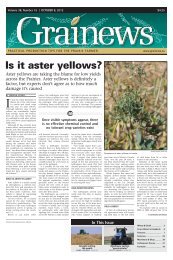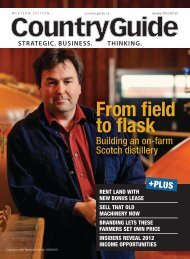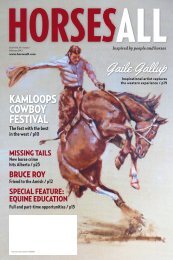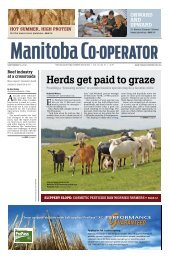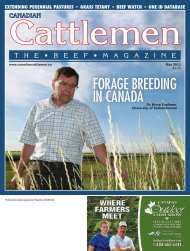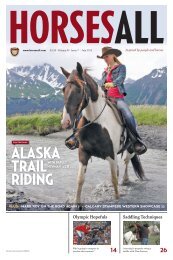MARKETING
MARKETING
MARKETING
Create successful ePaper yourself
Turn your PDF publications into a flip-book with our unique Google optimized e-Paper software.
Continued from page 45<br />
B u s i n e s s<br />
tive convenants) should stand,” says Matt<br />
Setzkorn, OFT’s policy co-ordinator.<br />
The conservation body doesn’t necessarily<br />
have to buy the land, as it did in<br />
the Jenkins case. More often landowners<br />
decide to have a conservation easement<br />
placed on their land because they want<br />
to ensure the ecologically sensitive or<br />
agricultural features of their property<br />
will remain protected after the property<br />
is sold or transferred.<br />
The landowners may also be motivated<br />
by tax credits. The difference in<br />
value of the property before and after<br />
a conservation easement is the value of<br />
the donation receipt to which the landowner<br />
is entitled. This may also reduce<br />
the municipal property tax assessment,<br />
although this must be pursued individually<br />
with property tax officials.<br />
Not all easements qualify as ecological<br />
gifts. For a donation of a conservation<br />
easement, common-law covenant or<br />
full title to be an eco-gift, Environment<br />
Canada must certify that the land is ecologically<br />
sensitive and it must also certify<br />
a fair market value for the donation. For<br />
more information on the Ecological Gifts<br />
Program, contact Environment Canada<br />
at www.ec.gc.ca.<br />
As of June 2006, landowners in<br />
Alberta had donated or sold conservation<br />
easements covering about 74,000<br />
acres and donated or sold fee simple title<br />
covering about 100,000 acres to conservation<br />
organizations. Of these lands<br />
47,000 acres qualified as ecological gifts<br />
valued at about $42 million.<br />
“The property value usually is lowered<br />
with these easements and for that<br />
change in value you can get a tax credit,<br />
if your property is deemed to have special<br />
qualities,” says Jennifer Stevenson,<br />
business adviser with the Ontario Agriculture<br />
Ministry. “Anything above the<br />
capital gains tax exemption, you get<br />
extra tax credits.”<br />
The tax benefits of a conservation<br />
easement can sometimes be used to help<br />
with farm succession. The process also<br />
forces families to talk about a vision for<br />
the property and try to match that with<br />
personal wants and needs.<br />
“An agricultural conservation easement<br />
is also a tool for succession planning<br />
as it provides a formal agreement<br />
outlining provisions to ensure that one’s<br />
land may provide a specific use for<br />
future generations,” says Stevenson.<br />
When the Jenkins began negotiating<br />
with the NCC they hired a good lawyer<br />
who had previously worked with conservation<br />
easements. “Get a lawyer experienced<br />
with conservation easement to set it<br />
up properly,” Jen recommends.<br />
Covenants usually are negative, not<br />
allowing for particular activities or land<br />
uses. For example, a covenant might<br />
prevent subdivision of the property or<br />
require that the property be used for<br />
farming only, or not allow the removal<br />
of certain vegetative species within designated<br />
natural zones.<br />
Since they were already using good<br />
land stewardship practices, the Jenkins<br />
didn’t have to change how they operated<br />
their ranch.<br />
Jen and Bob maintain control of<br />
how the land is grazed and subsequently<br />
many other area ranchers now have<br />
agreements with the NCC. Some of them<br />
are based on purchases, as with the Jenkins,<br />
while others are based on conservation<br />
easements. Today the Waterton<br />
Park Front project is one of the largest<br />
private land conservation initiatives in<br />
Canada, conserving over 30,000 acres of<br />
ranchland.<br />
Covenants can also allow activities<br />
such as responsible forestry, usually<br />
according to a named set of practices<br />
or a management plan attached to the<br />
easement. The easement portion of the<br />
agreement grants to the holder, among<br />
other things, access for the purpose of<br />
inspecting the property and the right to<br />
take action to remedy any deficiencies.<br />
It also usually outlines terms such as<br />
giving notice of inspection to the landowner.<br />
Jen works well with the two or three<br />
NCC staff in the area and over the years<br />
has partnered with the NCC to do a few<br />
conservation projects, such as fencing<br />
riparian areas.<br />
Bob and Jen own everything on the<br />
land, such as the houses. There are three<br />
family homes on the ranch. One concession<br />
they made to the family was that<br />
the descendants could come back, use<br />
their family homes any time and enjoy the<br />
property, ride horses or go for a walk.<br />
That agreement has worked out fine<br />
but Jen’s ability to build a home for<br />
herself to replace her mobile home is<br />
curtailed.<br />
There’s another hitch too. Ownership<br />
of capital assets wasn’t something Jen<br />
thought would be important when she<br />
was younger.<br />
However, loaning agents want land<br />
as collateral. “I didn’t see that it would<br />
leave me with little borrowing power,”<br />
says Jen.<br />
Normally they would have managed<br />
through this limitation but May 2003<br />
changed everything. During the winter,<br />
Jen and Bob had bought 100 cow-calf<br />
pairs intending to resell them after grassing<br />
them over the summer. When the<br />
border shut down because a Canadian<br />
animal tested positive for bovine spongiform<br />
encephalopathy (BSE), suddenly<br />
those cows were worth nothing.<br />
And all their cash flow was tied up in<br />
cattle. “All our cash had gone back into<br />
building the herd,” says Jen.<br />
Once the shock had settled, Jen<br />
gathered her financial information and<br />
invited her banker out to the ranch to<br />
talk about a bridging loan. She poured<br />
out her story. “Then he said I should<br />
evaluate what I wanted to do and suggested<br />
I get a job at Walmart.”<br />
Now spurred on with a little anger,<br />
she called a senior economist from<br />
Alberta Ag and got some good advice.<br />
She went back to the books and did five<br />
years of full budgeting and presented<br />
it to two other banks with no luck. “It<br />
forced me to step up my game,” she says.<br />
Finally Jenkins went into Lethbridge<br />
to meet with FCC. “I’ll always remember<br />
that moment,” she says. “He met me<br />
with optimism, and said it was going to<br />
get better.”<br />
Now she figures it’s time to give that<br />
positivity back to other new farmers.<br />
She’s recently started acting as a facilitator<br />
for FarmOn (www.farmon.ca).<br />
Her role there is to listen, let farmers<br />
know they are not alone and help them<br />
set up a team of people and information<br />
to get them through their challenges.<br />
Her services are free and she has a large<br />
resource board behind her who help connect<br />
to the resources.<br />
“Often we’re trying to do it all, financial<br />
management, marketing, production,<br />
ownership, human resources,” Jen<br />
says. “Sometimes it’s a matter of letting<br />
someone else help you and it doesn’t necessarily<br />
cost a bundle.”<br />
Jen started her online connection<br />
with a woman’s group. These online<br />
chats and conferences led her to the<br />
FarmOn site. “I want to facilitate people<br />
building the future of agriculture,” Jen<br />
says. “I know what it feels like to be<br />
alone trying to make a go of it. I’m there<br />
to listen, online.” CG<br />
4 6 c o u n t r y - g u i d e . c a s e p t e m b e r 1 7 , 2 0 1 2



